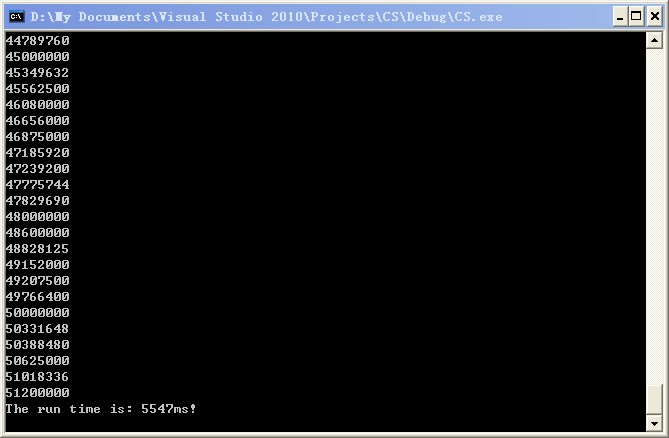只包含因子2,3,5的数称作丑数。要求按从小到大的顺序输出指定数量的丑数。
有2中方法:
第一种:用穷举法,从最小的1开始判断穷举,是丑数就输出,否则继续循环判断。判断的方法是:如果一个数能被2整除,我们把他连续除以2;如果能被3整除,我们把他连续除以3;如果能被5整除,我们把他连续除以5。如果最后得到的值为1,那么这个数就是丑数。具体代码如下:
1 ////////////丑数/////////////////////// 2 3 bool isUgly(int number) 4 { 5 assert(number > 0); 6 while (number % 2 == 0) 7 { 8 number /= 2 ; 9 } 10 while (number % 3 == 0) 11 { 12 number /= 3 ; 13 } 14 while (number % 5 == 0) 15 { 16 number /= 5 ; 17 } 18 19 return (number == 1) ? true : false ; 20 } 21 void GetUgly1(int index) 22 { 23 if (index <= 0) 24 { 25 return; 26 } 27 int number = 0 ; 28 int count = 0 ; 29 while (count < index) 30 { 31 ++number; 32 if (isUgly(number)) 33 { 34 count++ ; 35 cout<<number<<endl; 36 } 37 } 38 }
1 int main() 2 { 3 unsigned long start_time = GetTickCount(); 4 GetUgly1(1000); 5 unsigned long end_time = GetTickCount(); 6 cout<<"The run time is: "<<(end_time-start_time)<<"ms!"<<endl;//输出运行时间 7 getchar(); 8 return 0; 9 }
输出1000个丑数的结果如下图:

第二种:
用空间换时间,创建一个数组,里面的数字是排好序的丑数,下一个丑数是前面丑数乘以2、3、5得到的大于当前最大丑数的最小一个数。和第一种思路相比,第二种思路不需要在非丑数上做任何计算,因此时间效率会明显提升,但增加了空间消耗。具体代码如下:
1 int Min(int num1 , int num2 , int num3) 2 { 3 int min = (num1 < num2) ? num1 : num2 ; 4 return (min < num3) ? min : num3 ; 5 } 6 7 8 void GetUgly2(int index) 9 { 10 if (index <= 0) 11 { 12 return ; 13 } 14 int* pUglyNumbers = new int[index]; 15 pUglyNumbers[0] = 1 ; 16 int* pUglyNumbers2 = pUglyNumbers ;//指向丑数乘以因数2后得到的最大丑数的位置,起始位置为pUglyNumbers[0] 17 int* pUglyNumbers3 = pUglyNumbers ;//指向丑数乘以因数3后得到的最大丑数的位置,起始位置为pUglyNumbers[0] 18 int* pUglyNumbers5 = pUglyNumbers ;//指向丑数乘以因数5后得到的最大丑数的位置,起始位置为pUglyNumbers[0] 19 int NextUgly = 1 ; //下一个丑数存储的位置 20 while ( NextUgly < index ) 21 { 22 int min = Min((*pUglyNumbers2) * 2 , (*pUglyNumbers3) * 3 , (*pUglyNumbers5) * 5) ;//取最小的值作为下一个丑数 23 pUglyNumbers[NextUgly] = min ; 24 25 while ((*pUglyNumbers2) * 2 <= min) //改变pUglyNumbers2的位置,使其指向后续所有丑数乘以因数2后得到的最大丑数 26 { 27 pUglyNumbers2++ ; 28 } 29 while ((*pUglyNumbers3) * 3 <= min) //改变pUglyNumbers3的位置,使其指向后续所有丑数乘以因数3后得到的最大丑数 30 { 31 pUglyNumbers3++ ; 32 } 33 while ((*pUglyNumbers5) * 5 <= min) //改变pUglyNumbers5的位置,使其指向后续所有丑数乘以因数5后得到的最大丑数 34 { 35 pUglyNumbers5++ ; 36 } 37 38 NextUgly++ ; 39 40 } 41 42 for (int i = 0 ; i < index ; i++) 43 { 44 cout<<pUglyNumbers[i]<<endl; 45 } 46 47 delete[] pUglyNumbers ; 48 49 } 50 51 int main() 52 { 53 unsigned long start_time = GetTickCount(); 54 GetUgly2(1000); 55 unsigned long end_time = GetTickCount(); 56 cout<<"The run time is: "<<(end_time-start_time)<<"ms!"<<endl;//输出运行时间 57 getchar(); 58 return 0; 59 }
输出1000个丑数的结果如下图:

可以看见第二种方法时间效率提高了10多倍!!